How greed and politics are slowing the switch to renewable energy
By Andrew Dessler | January 17, 2022
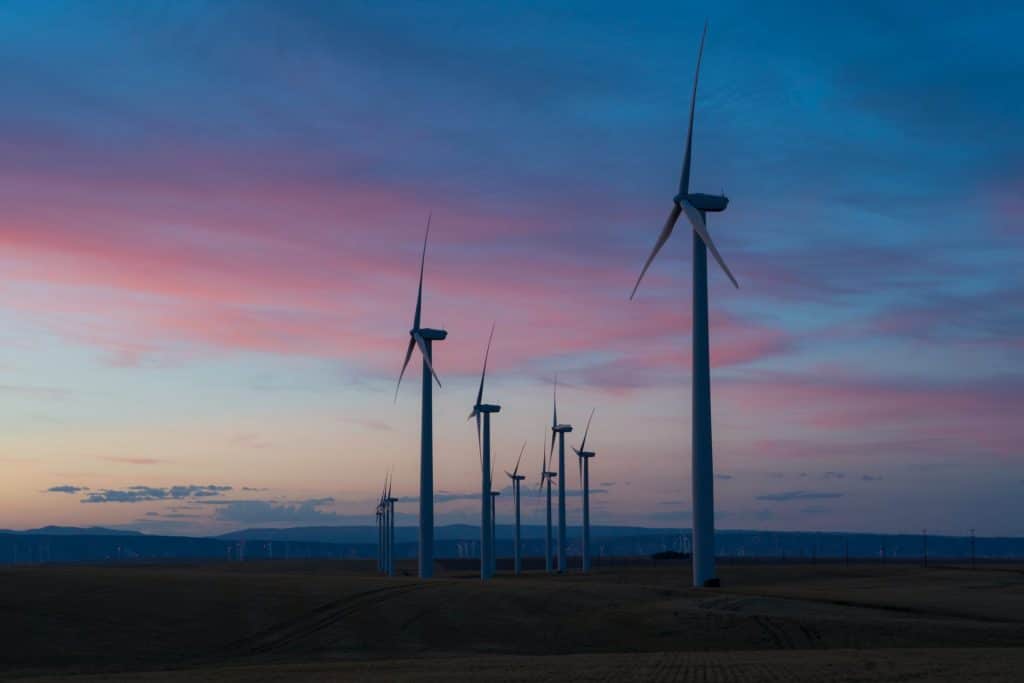
It is (with apologies to Charles Dickens) the best of times; it is the worst of times.
Thanks to fossil fuels, billions of people in 2022 enjoy lives of wealth, comfort, and material possessions unimaginable before the industrial revolution.
But fossil fuels have their dark side. You might think you understand that, but it’s likely fossil fuels are even worse for the world than you think. Let’s start with climate change. Contrary to what you might hear listening to Fox News, the scientific understanding of climate change is good and it is progressing at exactly the rate predicted decades ago by Exxon.
What you probably don’t realize is how massive these changes may be. In the depths of the last ice age 20,000 years ago, the Earth was only 6 degrees Celsius colder than it is today. That world—with thousands of feet of ice sitting over much of North America, sea level 300 feet lower, and completely different ecosystems—would be unrecognizable to those living on today’s Earth.
This helps us put predictions of future warming into context. The chart below shows predictions for the twenty-first century, but instead of units of temperature, I have plotted units of ice ages, where one ice age unit equals 6 degrees Celsius. Business-as-usual emissions gives us about 3 degrees Celsius of warming in 2100—about half of one ice-age unit. Given how much the Earth has changed since the last ice age, 3 degrees Celsius of warming may well remake the planet, leading to an Earth in 2100 as unrecognizable to us today as the world of the last ice age.
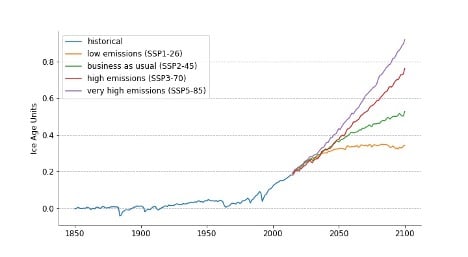
The Earth is presently about 1.1 degrees Celsius above preindustrial temperatures, so we have already warmed about 17 percent of an ice age, and the impacts are clear. For example, there is widespread agreement in the scientific community that climate change contributed to the unprecedented rainfall during Hurricane Harvey in 2017, and that the massive heatwave in the Pacific Northwest last year could not have occurred without global warming.
But fossil fuels cause even more insidious damage. Billions of people today live in air polluted by fossil fuel combustion. This harms people in surprisingly numerous ways. One fact that stands out: One in five deaths worldwide is due to air pollution, amounting to more than 8 million deaths every year.
But fossil fuels are even worse than that. As commodities whose price is set on the world market, international politics can cause the price to whipsaw. Oil price spikes associated with Middle East conflicts, oil embargoes, and other political events have often been followed by painful economic recessions. In 2020, the price of oil dropped significantly because of the coronavirus pandemic combined with a price war between Russia and Saudi Arabia. This laid waste to the US oil industry, bankrupted oil producers, and increased unemployment.
As a consequence, US foreign policy over the last 70 years has been hyper focused on maintaining stability in the world energy market. This has led the United States, for example, to invade Iraq twice, first in 1990 and then again in 2003, starting wars that cost the United States trillions of dollars; hundreds of thousands of lives of people of many nationalities were lost.
Putting everything together, one conclusion is clear: Fossil fuels are terrible. While many people in 2022 are living much better lives because of fossil fuels, people in 2100 will be much worse off because of them.
The story doesn’t end there. The world needs power. People need it so much, in fact, that as bad as fossil fuels are, people would continue to use them if there were no alternatives. But we do have an alternative: renewable energy. This means primarily wind and solar energy, although other energy sources (e.g., geothermal) will also play a role. Non-renewable energy sources such as nuclear could provide another source of climate-safe energy.
The amount of renewable energy available is almost unfathomable. Human society consumes about 15 terawatts of power. Sunlight falling on the earth provides more than 100,000 terawatts, enough to power 7,000 human civilizations. There are obviously issues with the intermittency of solar and wind. The sun is not always shining everywhere, not at night nor when it is cloudy. Similarly, the wind does not always blow.
However, a huge amount of research has gone into how to build a reliable energy system that relies predominantly on intermittent renewable energy. First, wind and solar power tend to be uncorrelated, so a system combining these energy sources will have more consistent power than a system that is solar- or wind-only. Thus, diversifying your energy portfolio solves a lot of the intermittency problems.
Second, we need to be able to transport power. While the sun may not be shining or the wind blowing where you are, the sun is always shining and the wind is always blowing somewhere. By enhancing our electrical grids, power can be shifted regionally from where it’s generated to where it’s needed, further reducing the impact of intermittency of solar and wind power.
Third, intermittency becomes an even smaller problem if part of the energy mix is dispatchable climate-safe energy. This means power sources that are available at any time and can be dispatched at the request of electric grid operators, including always-on energy sources such as hydroelectric, geothermal, nuclear, or natural gas with carbon capture.
Fourth, we need demand response. At times when supply simply cannot keep up with demand, we need to be able to reduce demand. This can be as simple as asking large industrial consumers to reduce their consumption. Or utilities can change consumption patterns by making power cheaper when it’s abundant and more expensive at times when it’s not. Smart appliances in homes can automatically delay running the dishwasher or drying clothes for a few hours when the utility signals that the supply of power is tight; in return for this, consumers get a break on their electricity bill.
Finally, we need energy storage. This could help the grid equalize supply and demand by storing power from wind and solar energy when there is excess supply and releasing it when there is excess demand. The price of batteries has been dropping rapidly and, as discussed below, we already see plans for more storage on the grid. Much research today is focusing on other technologies to store energy, including compressed air, hydrogen, pumped hydroelectric, and gravity energy.
The upshot of this is that we can largely run our economy on renewable energy. There are some edge cases where decarbonization might be hard (e.g., international airline flights), but this should not stop us from gathering the low-hanging fruit.
This leads me to the other piece of misinformation you’ll often hear: A renewable energy grid will be expensive.
There was a time when that was the case, but today the picture is quite different. Wind and solar are now as cheap as the cheapest fossil fuel power, if not cheaper. And these price comparisons typically do not include the costs of climate change, air pollution, and price variability from fossil fuels. Those costs represent an enormous subsidy for fossil fuels and, if you include them, fossil fuels become far more expensive than renewable energy.
In response to this, the market is decisively moving away from fossil fuels. In Texas, for example, 95 percent of the energy connections to the electrical grid planned for the next four years are for renewable energy (60 percent solar, 16 percent wind, 18 percent battery).
It’s great news that our electricity system is already switching over to renewable energy. But it’s not happening fast enough. On our present trajectory, we will continue to use fossil fuels well into this century, leading to warming of 3 degrees Celsius above pre-industrial temperatures by 2100, well above the target that the world has agreed upon, 1.5-2 degrees Celsius. Given that our present warming of 1.1 degrees Celsius is already causing severe and expensive impacts, 3 degrees Celsius would be a planetary disaster.
The transition has been sluggish because the price of fossil fuels is kept artificially low. Consumers and businesses do not pay the full cost of the climate, health, and other related costs of fossil fuel use. This could be largely solved by making consumers pay the full cost of their energy through a carbon tax or cap and trade system. If society had to pay the full costs of energy, fossil fuels would quickly disappear from the energy market.
The climate problem is therefore quite simple: Fossil fuels are terrible for humanity, and we can switch at relatively low cost to an economy largely powered by renewable energy. So why aren’t we doing that?
The blame, in my view, lies with economists. Not all economists, mind you, but a group of influential thinkers in the mid-20th century who pushed governments towards implementing an extreme view of free markets. They also said that the social responsibility of corporations was to make as much money as possible. One of the most influential of these thinkers, Milton Friedman, called this the Friedman Doctrine. It was immortalized by Oliver Stone in the movie Wall Street, when one of the main characters proudly declares, “Greed is good!”
Beginning in the 1970s and 1980s, the United States saw government oversight shrink while corporations became laser-focused on profits. This deregulation effort delivered benefits like cheaper airline tickets for consumers. But the lack of government oversight combined with the imperative to make profits as large as possible also resulted in some terrible outcomes. These include climate change and the skyrocketing price of lifesaving drugs like insulin.
The fundamental problem is that free markets can’t solve environmental problems. Most environmental problems are externalities, or costs imposed on people who are not part of the transaction. Climate change is a classic externality—if you consume a gallon of gas or a kilowatt of electricity, the resulting carbon dioxide causes climate change everywhere, thereby imposing costs on everyone in the world. The costs of this climate change are not paid by the consumer, so this is a hidden subsidy of fossil fuels.
To corporations, externalities are terrific! If the goal of a corporation is to make as much money as possible, then it wants to push as many of the costs onto society as possible, which increases corporate profit. Because externalities benefit corporations, solving problems that arise from them, like climate change, requires government regulation. If the government is unwilling to regulate in some fashion, then climate change will never be fixed.
Following the Friedman Doctrine, corporations work hard to ensure that our government is not able to regulate. They funnel enormous quantities of money into the political process. This includes lobbying for preferred legislation and working to elect candidates who, once in office, return the favor by passing laws that support continued use of fossil fuels. For example, dozens of state legislatures have passed laws that criminalize protest around oil and gas infrastructure. In Texas, recent laws have forced the state’s investment funds to divest from institutions that boycott fossil fuels and prohibited Texas cities from exercising local control over drilling regulations, after the city of Denton banned fracking.
Fossil fuel corporations have also tried to stifle regulation by spending millions of dollars over the last few decades casting doubt on the science of climate change, despite their own researchers accurately assessing the risk. This closely paralleled what tobacco corporations did decades earlier. This shows the true problem with our version of free-market, profit-maximizing economics: Today’s economy does not create wealth that makes everyone better off, but rather generates enormous benefits for corporations while generating few benefits or even net harms for everyone else.
In the end, climate change is not a scientific or technical problem. The scientific community understands how fossil fuels cause climate change, and technology to solve the problem exists. Rather, climate change is a political problem. We need to return to the 1970s, a time when Republicans and Democrats overwhelmingly passed legislation forming the EPA. We need to understand that a world in which corporations care only about maximizing profits demands that the government protect the interest of the people.
Together, we make the world safer.
The Bulletin elevates expert voices above the noise. But as an independent nonprofit organization, our operations depend on the support of readers like you. Help us continue to deliver quality journalism that holds leaders accountable. Your support of our work at any level is important. In return, we promise our coverage will be understandable, influential, vigilant, solution-oriented, and fair-minded. Together we can make a difference.
Keywords: climate crisis, climate politics, democracy, fossil fuels, ice ages, renewable energy, transition from fossil fuels
Topics: Climate Change, Opinion











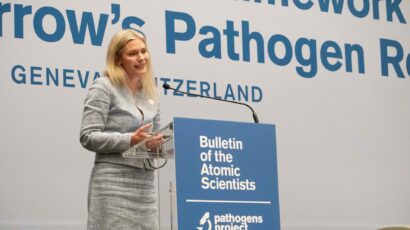


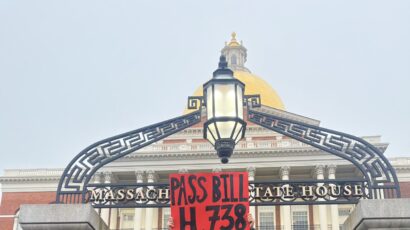
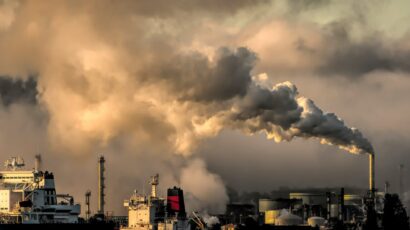
Andrew Dessler in his Greed and Politics article is correct in his assessment that free markets can’t solve environmental problems. Where he goes wrong is his solution. Wind and solar renewables can’t solve climate change either, not in the time we have available. He talks about the costs of fossil fuel combustion that are paid by society as a whole. He doesn’t talk about the costs of wind and solar that are paid by society as a whole. Costs like land and ocean space that are consumed by these low energy density sources. Costs like environmental pollution from mining and… Read more »
It’s not greed. It’s self-interest. That’s the principle upon which the entire mental ecology of modern finance is built. And Finance is what is stopping action on climate inaction.
We need to evolve a new story for getting to a new and better economy so that we can keep our society ongoing in the 21st Century and beyond.
A story that is powered by prudent stewardship, not self-interest.